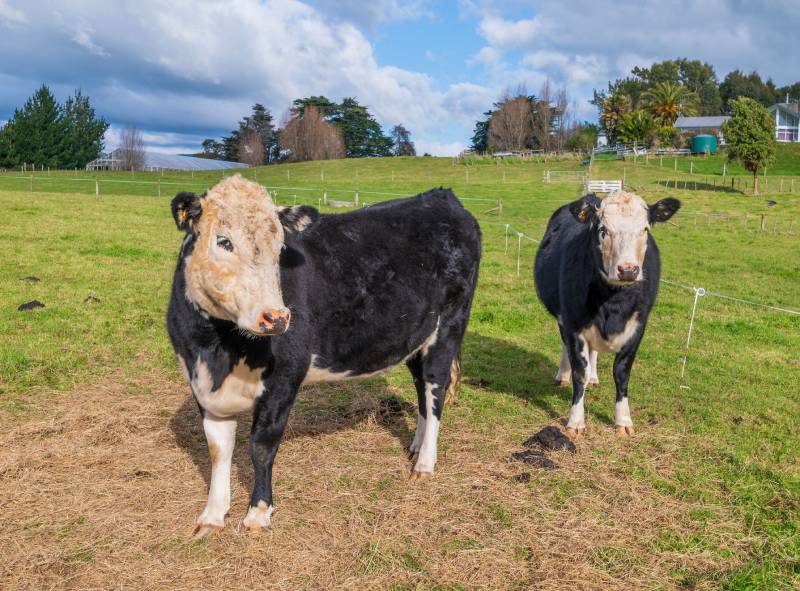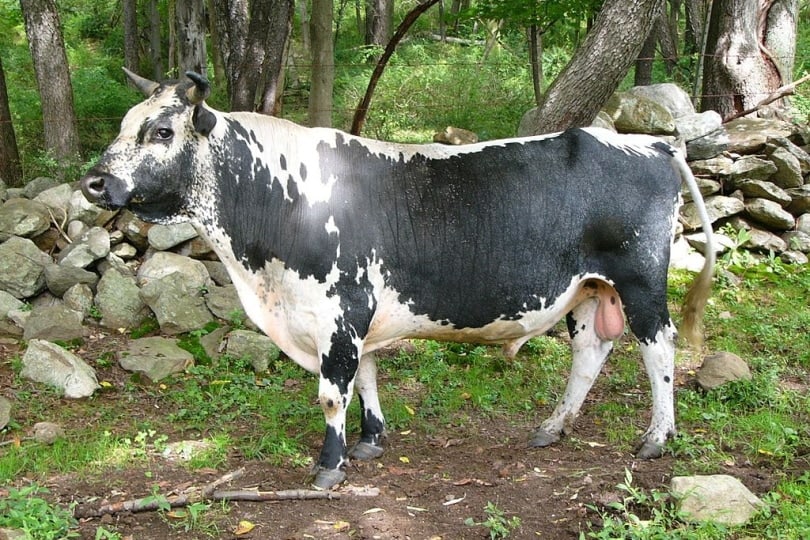The Lineback cattle breed is named for the white line that runs down their back. This unique breed is rarer and can be more challenging to find than others. However, they make excellent dairy cows and are moderately easy to care for. This breed is also a hardy one, known for its longevity and durability.

Quick Facts About Lineback Cattle Breed
| Breed Name: | Lineback |
| Place of Origin: | America |
| Uses: | Dairy |
| Bull (Male) Size: | 1,000 – 1,800 lbs |
| Cow (Female) Size: | 600 – 1,100 lbs |
| Color: | Black & white, roan & white |
| Lifespan: | 15 – 20 years |
| Climate Tolerance: | All climates |
| Care Level: | Easy to moderate |
| Milk Production: | Good |
Lineback Cattle Breed Origins
This rare American breed originated somewhere in the 18th or 19th century. Most likely, they came about because of cattle breeds being imported as English and Dutch settlers moved to the states—breeds such as the Gloucester and Welsh. Later, in the 19th century, farmers wanted to improve their stock, so they looked to incorporate the English Longhorn, Friesians, Herefords, Ayrshires, and Milking Shorthorns into their Lineback herds. Then, after World War II, dairy farmers incorporated Holstein bulls into herds to improve dairy yields.


Lineback Cattle Breed Characteristics
The Lineback cattle breed is known for having a docile but very stubborn temperament. This makes them a mix of easy to get along with but sometimes difficult to control. They are also fairly energetic. However, temperament will vary by cow because of the diverse background of the Lineback, so you never quite know what you’ll be getting.
This cattle breed is fairly hardy with few health problems. They’re known for having good feet and legs, as well as great mammary systems. They’re also known for their durability and longevity. On the flip side, you may run into calving difficulties depending on the cow’s bloodline.
When it comes to production, this breed is capable of up to 2 gallons of milk a day that is high in protein and fat, with a good dairy character.
Keeping Lineback cattle is relatively easy because this breed is well suited for free-stall housing and grazing. However, because of their personality (and the variance within), these cows may be difficult for beginners to handle.

Uses
Though initially bred as a dual-purpose cow (milk and meat), at some point, farmers began to specialize the Lineback for dairy production. So, over the years, the Lineback has become chiefly a dairy cow—though they’re still versatile—as they are good milkers who yield an average of up to 2 gallons of milk a day. The Lineback is also commonly kept as a “productive pet”.
Appearance & Varieties
The Lineback cattle breed is unique in that they have a white line going down the back (hence, the name). Most often, you’ll see a Lineback that is all black except for the line down the back (and the belly), which will be white. However, this breed can also be roan and white.
There are also a couple of color variations within the breed, known as the Witricks and the Gloucester. The Witrick pattern has three variations of its own—white classic, dark speckle, and dark sided. With the Witrick, most cows will have tiny black specks that make their coats look a blueish gray, but they can also come in red. The Gloucester will be black on its head, legs, and sides but will be white around the top of the legs, belly, and line on the back.
It should also be noted that Lineback refers not only to a breed but also to appearance. Breeds other than the Lineback may end up with a line going down their back.
Population
While there are several thousand Linebacks in the United States at this time, they are a rarer breed—some of which are critically rare. Efforts are being made to maintain and preserve the breed, though. However, that means if you’d like one of your own, you may have trouble finding one.

Are Lineback Cattle Good for Small-Scale Farming?
Lineback cattle can be good for small-scale farming due to the ease of keeping them, as they do well with free-stall housing and grazing. Plus, they are quite hardy with few known health issues (though you may run into calving difficulty depending on the bloodline). However, they may also not be the best for small-scale farming due to their stubborn natures, which can make them a challenge to manage. There’s also a chance you’d have difficulty finding one in the first place.

Conclusion
The Lineback cattle breed is a unique one. Though it has been around for a very long time, they are much rarer these days. They make great “productive pets”, and dairy cows but may not be the most suited for beginners or small-scale farming due to their stubborn natures.
Featured Image Credit: Randall Bull Andy (Image Credit: CTPhil Wikimedia Commons CC0 1.0)
